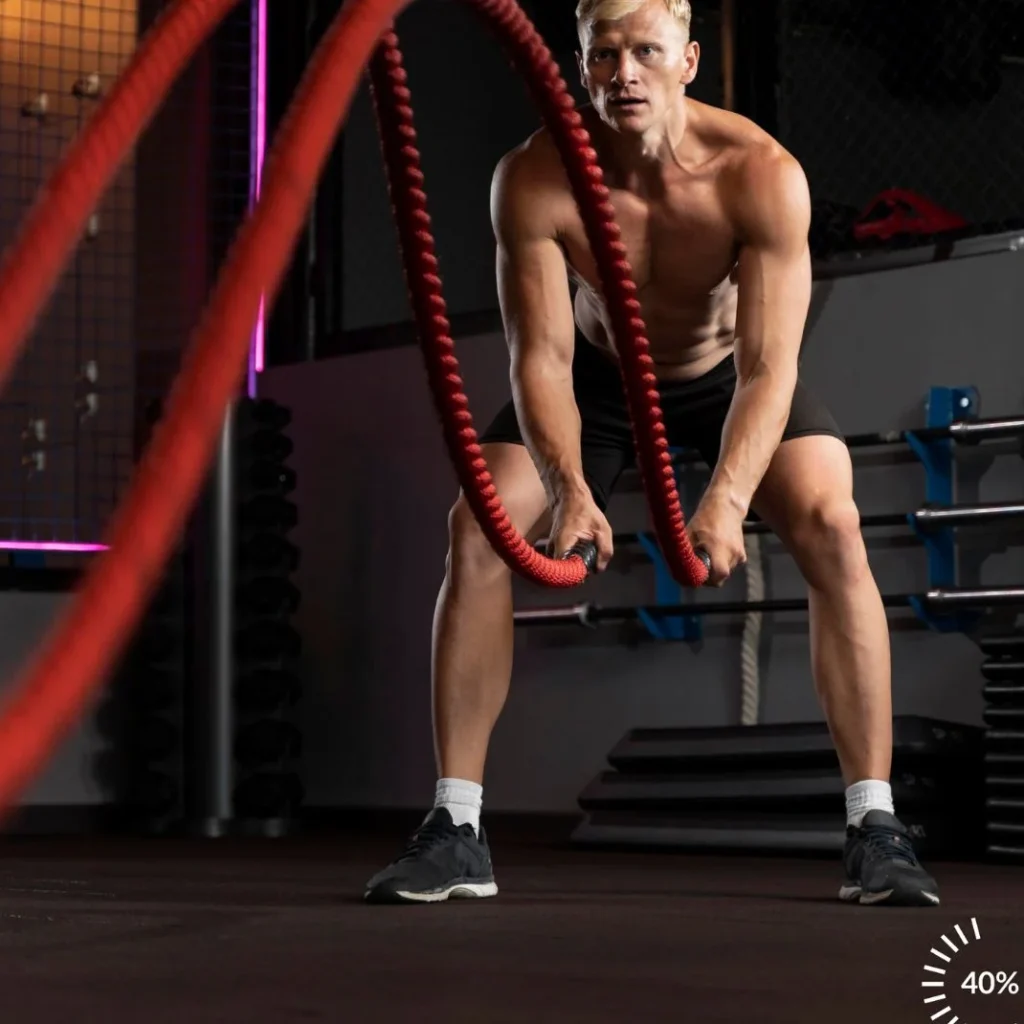Do you feel trapped with going up the same weight week after week? The secret that enables an advanced lifter over a beginner is progressive overload. This mantra is capable of transforming your gym sessions into muscle-growing machines.
Now, we are going to find out the in-depth details about the progressive overload and the way this system should be applied.
What Is Progressive Overload?
Progressive overload refers to a progressive stress or added load on the muscles in the course of a workout. This entails making it a habit of pushing your body to the limit by progressive weight, reps, sets, or even intensity level of the exercise.
Your body gets used to stress. When you lift a weight of the same weight over and over again, your body adjusts to it. Progressive overload instructs your muscles to work more, and that is what contributes to their growth and strength.
It is like climbing stairs. Every step is not a big challenge. You need the next step in order not to remain at the same stage forever.
What Is a Good Example of Progressive Overload?
And here is a little one:
- Week 1: 100-pound bench press, sets of 8 reps.
- Week 2: Do 3 sets of 10-rep sets at 100 pounds bench press.
- Week 3: 105 pounds on the bench press and do 3 sets of 8 reps.
- Week 4: Bench press with 105 pounds, 3 sets of 10 reps per set
This pattern is a gradual progression with weight increase. Another example is increasing sets: Month 1: Squats 3 sets × 12, Month 2: Squats – 4 sets of 1,2, Month 3: Squats – 5 sets of 12
How to Correctly Do Progressive Overload
1. Start Conservative
Start with weights that you can work with at ease. You ought to accomplish all the reps using 2-3 reps left in your tank.
2. Monitor your exercises
Record all your exercises, weights, sets, and reps. What you can improve, you measure.
3. Progress Gradually
Add 2.5-5% weight when you can achieve all sets and reps with full form.
4. Make it Form-First
Never slacken the form to the heavier weight. Injury and a decrease in muscle activation are achieved due to poor form.
5. Be Patient
Muscle development is time-consuming. One should expect observable impacts within 6-8 weeks of regular training.
What Is the 2 for 2 Rule for Progressive Overload?
The 2 for 2 rule is simple: If you can execute 2 additional reps after a target rep range in two consecutive workouts, you can increase the weight.
Example: Goal: 8-10 reps of 3 sets with 135 pounds. When you do 3 sets of 12 repetitions, two workouts in nsuccessionback up in weight to 140-145, and go back to 8-10 reps
This rule avoids the over-early gains in weight and proper adaptation.
What Is the 6-12-25 Rule?
The 6-12-25 rule arranges your fitness routine in a way most suitable to muscle development:
- 6 reps: Heavy compound movements (squats, deadlifts, bench press)
- 12 reps: Moderate weight isolation exercises (bicep curls, tricep extensions)
- 25 reps: Light weight-high-rep finishers (face pulls, lateral raises)
The regime attacks various fibres and training responses in a single workout.
Can You Build Muscle Without Progressive Overload?
It is very hard to gain substantial muscle mass without gradual overload. Your muscles require progressive stimulation to grow.

But, novices can initially benefit through:
- Better mind-muscle connection
- Improved shape and technique
- Higher frequency of training
These gains, however, peak rapidly. Progressive overload needs to take place over the long term to build muscle.
What Is a Realistic Progressive Overload?
Appropriate expectations of progressive overload:
New ones (0-6 months):
- 5-10 pounds per month of weight added to big lifts
- 2.5-5 pounds increase on smaller movements
Intermediate (6 months-2 years):
- 2.5-5 pounds per month gains in major exercises
- 1.25-2.5 pound increments on isolation exercise
Experienced (2+ years):
- 1.25-2.5 pound monthly increment rates
- Focus on rep and volume advancement
Should I Increase Weight or Reps?
A combination of the two methods is efficient. Pick according to your objectives:

Rep improvement for:
- Developing endurance muscle
- Learning new movements
- Healing an injury
- Training in the high reps (12 or more)
Weight increase for:
- Developing the greatest strength
- Training in lower reps (three to eight)
- When you reach max reps in your range
Some lifters use both methods in turns to balance it out.
Does Progressive Overload Build Muscle Faster?
Progressive overload is the quickest means of growing muscles naturally. Research has demonstrated that progressive exercise programs are 2-3 times more effective in growing muscles than static approaches.
Without progressive overload, your muscle quickly adapts to the current stress level, and the growth process halts. Constant change creates a necessity to constantly adapt.
How to Check Progressive Overload
Watch those numbers every week:
- Total weight lifted per exercise
- Average weight per exercise
- Total workout volume
- Time under tension (TUT)
- Rate of perceived exertion (RPE)
Use a training journal or an app to track and monitor progress.
How Many Reps for Hypertrophy?
The hypertrophy rep range is 6-20 rep range, the best being 8-15 rep range.
- 6-8 range – Strength generation, some muscle growth
- 8-12 range – Optimal hypertrophy growth
- 12-20 reps – Muscle endurance with some growth
Most bodybuilders train in the 8-12 rep range to build the greatest amount of muscle.
How Do You Know If You’re Overtraining?
Overtraining consists of such symptoms as:

- Constant lack of energy and fatigue
- Falling exercise performance
- Frequently injured
- Sleep disturbances
- Loss of drive
- Raised resting heart rate
- Frequent illness
When you have several of these symptoms, then cut down the intensity and the amount of training. Have a 3-7 day rest.
How Much Weight Is Progressive Overload?
Progressive overload weight increases:
- Compound movements (squats, deadlifts): 2.5-10 pounds
- Upper body compound (bench, rows): 2.5-5 pounds
- Isolation movements: 1-2.5 pounds
Use microplates (1.25 pounds) for smaller increments on lighter movements.
How Does Progressive Overload Feel?
Proper progressive overload should feel:
- Difficult but manageable
- Controlled difficulty
- Encouraging, not exasperating
- Progressively more challenging
You should not feel totally tired and lose form.
Is Progressive Overload Good for Weight Loss?
Progressive overload helps with weight loss by:
- Increasing muscle tissue that burns more calories
- Increasing the metabolic rate
- Creating increased workout intensity
- Maintaining muscle in caloric deficits
Fat loss depends on combining progressive training with proper nutrition.
Does Progressive Overload Make You Bulky?
Progressive overload in and of itself does not develop bulk. The size of muscles will depend on:
- Nutrition (positive or negative energy balance)
- Genetics
- Training volume
- Hormone levels
Women and men who have low levels of testosterone can practice progressive overload and not become too muscular.
How Many Days Should You Lift a Week?
Lifting frequency recommendations:
- Beginners: 2-3 times per week
- Intermediate: 3-4 times per week
- Advanced: 4-6 days a week
Allow 48-72 hours for recovery between training the same muscles.
What Is an Example of a Progressive Overload Workout?
Here is a 4-week progressive overload routine:
Week 1:
- Squats: 3 sets × 8 reps @ 135lbs
- Bench press: 3 sets × 8 reps @ 115 pounds
- Rows: 3 sets × 10 reps @ 95 lbs
Week 2:
- Squats: 3 sets × 10 reps @ 135lbs
- Bench Press: 3 sets × 10 reps @ 115 lbs
- Rows: 3 sets × 12 reps @ 95 lbs
Week 3:
- Squats: 3 sets × 8 reps @ 145 lbs
- Bench Press: 3 sets × 8 reps @ 120lbs
- Rows: 3 sets × 10 reps @ 100 lbs
Week 4:
- Squats: 3 sets × 10 reps @ 145 lbs
- Bench Press: 3 sets × 10 reps @ 120 lbs
- Rows: 3 sets × 12 reps @ 100 lbs
How Many Weeks Should I Do Progressive Overload?
Progressive overload must remain a thing in your training career. However, periodize your method:
- 4-6 weeks: Progressive overload approach
- 1 week: Deload (reduce 20-30% intensity)
- Repeat cycle
That way, you avoid plateaus and overtraining, and continue to make steady progress.
How Long Should I Rest Between Sets?

Rest periods for progressive overload:
- Heavy: 3-5 minutes
- Medium: 2-3 minutes
- Light: 1-2 minutes
Rest is important as it enables you to maintain intensity during the entire workout session.
Does Creatine Help Build Muscle?
Creatine helps build muscles by:
- Increasing workout intensity
- Improving recovery between sets
- Increasing muscle cell hydration
- Supporting muscle protein synthesis
To use it best, take 3-5 grams per day. Creatine works synergistically with progressive overload.
Conclusion
The basis of every effective muscle-building program is progressive overload. A good weight-building program allows your muscles to gradually get adjusted to the demands you put on them by steadily increasing the workload.
Keep in mind these main facts:
- Start slow and progress steadily
- Monitor all the workouts
- Emphasise form over weight
- Be patient with the process
- Listen to your body
Get the progressive overload right, and you will set the body into an extraordinary journey of transformation. One rep at a time, your future stronger self is waiting.
Frequently Asked Questions
1: What is progressive overload?
Progressive overload: This refers to an increment in weight, reps, or sets, in the long term. It causes muscles to change and increase to resist more stress with each workout.
2: What should be the progressive overload in the weights?
A: Add 2.5-10 pounds on compound exercises, 2.5-5 pounds on upper body and 1-2.5 pounds on isolation activities when you can finish the number of reps with proper form.
3: Which should I use, progressive overload increases in weights or reps?
Both are applicable. Lift more reps, but focus on strength and mastering new skills. Eat more to add mass in the quest to attain optimal strength, and as you approach your rep target range.
4: What is the time period that progressive overload takes to deliver?
A: After 6-8 weeks of continual progressive overload training, expect measurable muscular growth. New students can achieve some quicker progress in the beginning.






